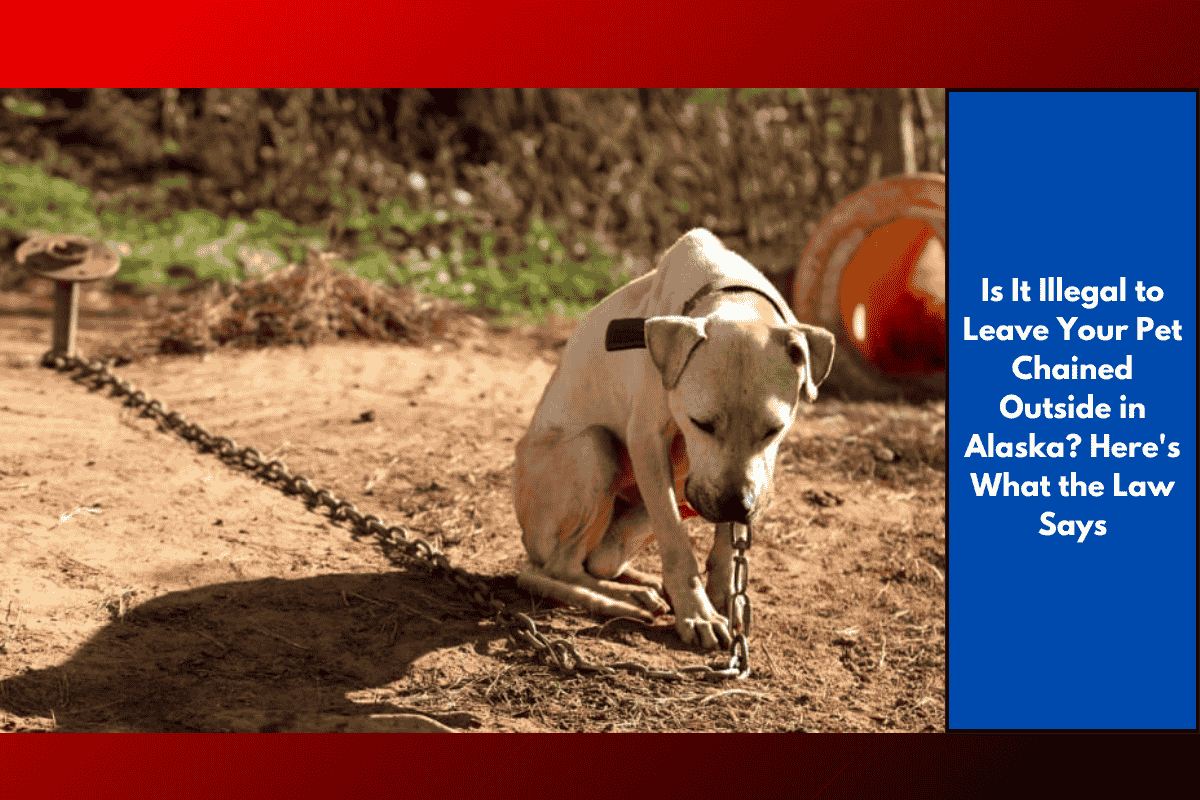In Alaska, as in many other states, pet owners are responsible for ensuring their animals’ well-being and safety. Leaving a pet chained outside for extended periods has raised concerns about animal cruelty and neglect. While Alaskans enjoy outdoor activities with their pets, it’s important to understand the legal aspects of keeping your pet chained outside. So, is it illegal to leave your pet chained outside in Alaska? Let’s break down the laws and regulations regarding pet care in the state.
Alaska’s Animal Cruelty Laws
Alaska has strong laws to protect animals from cruelty and neglect. These laws are designed to ensure pets and animals are not subjected to harmful or dangerous living conditions. The state’s animal cruelty laws prohibit actions that cause unnecessary suffering to pets and other animals, and leaving a pet chained outside in conditions that could harm it can be considered neglectful or abusive.
When Is It Illegal to Leave Your Pet Chained Outside?
While it is not outright illegal to leave a pet chained outside in Alaska, there are specific conditions that make it unlawful. Alaska law requires that pets have access to food, water, and shelter, and that their living conditions do not cause them harm or suffering. Here are some conditions under which leaving a pet chained outside could be considered illegal:
Lack of Shelter: If a pet is left outside without proper shelter, especially in extreme weather conditions (cold winters or hot summers), it could be considered neglect. The law requires that animals have adequate protection from the elements.
Failure to Provide Food and Water: A pet chained outside must have access to fresh food and water. If a pet is left without these necessities, it could be considered animal cruelty under Alaska’s laws.
Extreme Weather Conditions: Chaining a pet outside during extreme weather conditions, such as freezing temperatures, heavy snow, or extreme heat, could result in animal cruelty charges. Pets must be protected from environmental hazards.
Inadequate Length of Chain or Restraint: If a chain or restraint is too short, it can restrict the animal’s movement and cause physical harm. Chaining a pet in such a manner can be considered cruel or inhumane.
Neglect or Abandonment: Leaving a pet chained outside for long periods without interaction, attention, or proper care may result in neglect charges. Pets need social interaction, mental stimulation, and regular care from their owners.
Alaska’s Animal Cruelty Penalties
If a pet owner is found guilty of leaving their pet chained outside under dangerous or harmful conditions, they could face serious consequences under Alaska law. The penalties for violating animal cruelty laws can vary depending on the severity of the offense:
Fines: Pet owners may face fines for neglecting their animals, especially if the conditions lead to harm or distress.
Imprisonment: In cases where the neglect or abuse results in significant harm to the animal, a pet owner could face jail time.
Seizure of the Animal: If an animal is found in a harmful or unsafe situation, law enforcement may remove the pet from the owner’s care and place it in a safe environment.
How to Ensure Your Pet’s Safety Outside
If you do choose to keep your pet outside, there are steps you can take to ensure they are safe and comfortable:
Provide Adequate Shelter: Make sure your pet has a well-constructed shelter that protects them from wind, rain, snow, and extreme temperatures. The shelter should be insulated and dry.
Ensure Access to Food and Water: Always provide fresh food and water for your pet. Be sure to check regularly to ensure their needs are met.
Monitor the Weather: Keep an eye on the weather and bring your pet inside during extreme temperatures. Pets should not be left outside for long periods in severe cold or heat.
Use a Long, Safe Leash: Ensure the chain or leash is long enough for the pet to move around freely, without causing physical harm or limiting their natural movement.
Avoid Long-Term Chaining: Ideally, avoid leaving your pet chained for long periods. Instead, consider a secure, fenced area or a pet playpen where your animal has more space to roam and play.
In Alaska, it is not outright illegal to leave your pet chained outside, but it can be considered cruelty or neglect if certain conditions aren’t met. The law requires that pets be provided with proper shelter, food, and water, and that their living conditions do not cause harm or suffering. As a responsible pet owner, it’s essential to ensure your pet’s safety, especially when they’re kept outside. If in doubt, it’s always best to bring your pet inside or provide a safe, comfortable space where they can move freely and interact with their environment.
SOURCES
[1] https://www.animallaw.info/topic/table-state-dog-tether-laws
[2] https://dec.alaska.gov/eh/vet/import-export/pets/
[3] https://www.alaskaair.com/content/travel-info/policies/pets-traveling-with-pets/pets-in-baggage-compartment
[4] https://www.alaskaair.com/content/travel-info/pets
[5] https://www.peta.org/issues/animal-companion-issues/ordinances/valdez-alaska/














